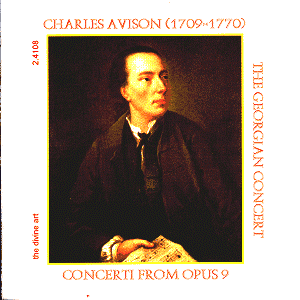 Composer: Charles Avison
Composer: Charles Avison
Works: Concerti from Opus 9: 1 in G, 9 in C minor, 7 in E flat, 8 in B flat, 4 in G minor, 6 in E minor
Performers: The Georgian Consort
Recording: DDD
Label: Divine Art 2-4108 [45.29]
Charles Avison, an often-overlooked figure in the landscape of 18th-century British music, emerges as a significant composer through his collection of concerti grossi, particularly those in his Opus 9. Born in Newcastle in 1709 and serving as the city cathedral’s organist from 1736 until his death in 1770, Avison’s contributions to the genre of the concerto grosso are notable for their structural ingenuity and musical expressiveness. The Georgian Consort’s interpretation of these works, released by Divine Art, offers listeners a chance to engage with the subtleties of Avison’s style, which blends the influences of Italian concerti with a distinctly British sensibility.
The performance by The Georgian Consort showcases a unique ensemble configuration that yields an intimate sound palette well-suited to the slow movements inherent in Avison’s concerti. Their approach, however, raises questions regarding the energy and vigor in the faster sections. The recording captures the ensemble’s delicate nuances, particularly in the Andante cantabile of the Eighth Concerto, where the siciliana rhythm evokes a reflective elegance, leaving listeners to ponder its emotive depth. Yet, while this elegance is commendable, it often lacks the requisite dynamism in the faster passages, which could benefit from a more vigorous articulation of the predominance of dotted rhythms that characterizes much of the faster music.
The engineering quality of this recording is commendable, allowing the texture of the music to shine through clearly, although it does not entirely compensate for the performance’s occasional lack of bite. The clarity of each instrument contributes to the overall understanding of Avison’s counterpoint and thematic development, but the quick movements, such as the lively Allegro of the Concerto in C minor, seem to underplay their inherent energy. This contrasts with other interpretations available in the catalog that draw out a more spirited performance, which may serve as a more effective means of communicating the joyous character embedded within these works.
Of particular note is the unusual structure of Avison’s concerti grossi, which often conclude with an aria, a reflection of his inclination towards lyrical expression and perhaps influenced by the liturgical music of his cathedral background. The final movements serve not just as closures but as explorations of musical character, inviting listeners to experience the intersection between instrumental virtuosity and expressive depth. The absence of ornate ornamentation, frequently found in the works of Avison’s contemporaries, is striking and serves to highlight his unique compositional voice, which prioritizes clarity of expression over embellishment.
This recording by The Georgian Consort presents a thoughtful interpretation of Avison’s concerti grossi, revealing much of the composer’s intellectual rigor and musical expressiveness. While certain performances may elicit greater dynamism in the rapid passages, the ensemble’s clarity and commitment to the lyrical aspects of Avison’s music are commendable. The interplay between the instruments is delicate and well-balanced, though a deeper exploration of energy in the faster movements could elevate the overall impact of the performance. This recording serves as a valuable contribution to the understanding of Avison’s work, and for enthusiasts of the Baroque repertoire, it provides an enriching glimpse into a composer who deserves greater recognition in the canon of classical music.



